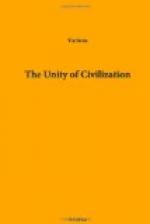Amid local and national diversities of law there were at any rate two unifying influences, the Roman and the Canon law. In some parts of Europe, as in the South of France and Italy, the traditions of the Roman law had never died out, and in a debased form, with much admixture of the law of the invaders, it had come to form the basis of the local law. In others it was the barbarian law which formed the groundwork. But just as behind the new languages, whether in the main founded on Latin or on Teutonic, Latin remained the medium of intercourse between the countries of the West, and the instrument of thought and learning, so Roman law remained a tradition which was ever ready to exert an influence. It is not only in law courts that law is learnt and developed. Transactions have to be drawn up in writing, and will largely be made in Latin, and founded on precedents. The grants of land to and from ecclesiastical bodies especially will be in a form which borrows much from Roman or romanesque models; and they will form models for the transactions of others. Even the formulation of native law in the early codes will be carried out by men who know of no written law except the Roman. In the twelfth century Roman law becomes a subject of University study throughout Western Europe, in Italy, at Paris, even at Oxford, and forms a part of that international learning which scholars carry from land to land. Men trained in the Roman law rise to high positions in the public service. As judges and administrators they will not forget what they have learnt as students or taught as doctors. Yet it would be easy to exaggerate its influence, great as it was. It was certainly more as a form and method of legal thought than as an actual source of legal rules that it made itself felt, for instance, in our own country, and the strength and cohesion which it helped to give to our law enabled that law later to resist its further advance.
The Canon law was the law of the Western Church, a truly international society. It was formed largely on the model of the Roman law, and it largely borrowed from it, though it is full of non-Roman elements. It governed not merely what we should call purely ecclesiastical matters, but dealt or attempted to deal with other things, such as marriage and the disposition of the goods of the deceased. Our own law of marriage and divorce, and of probate of wills, has a history which goes back to the ecclesiastical law of the Middle Ages. Like the Roman law it exercised an influence as a model and a repository of maxims, all the greater because in every country it was a law in actual force within a sphere of which the boundaries were constantly being disputed between the lay and the church powers.




